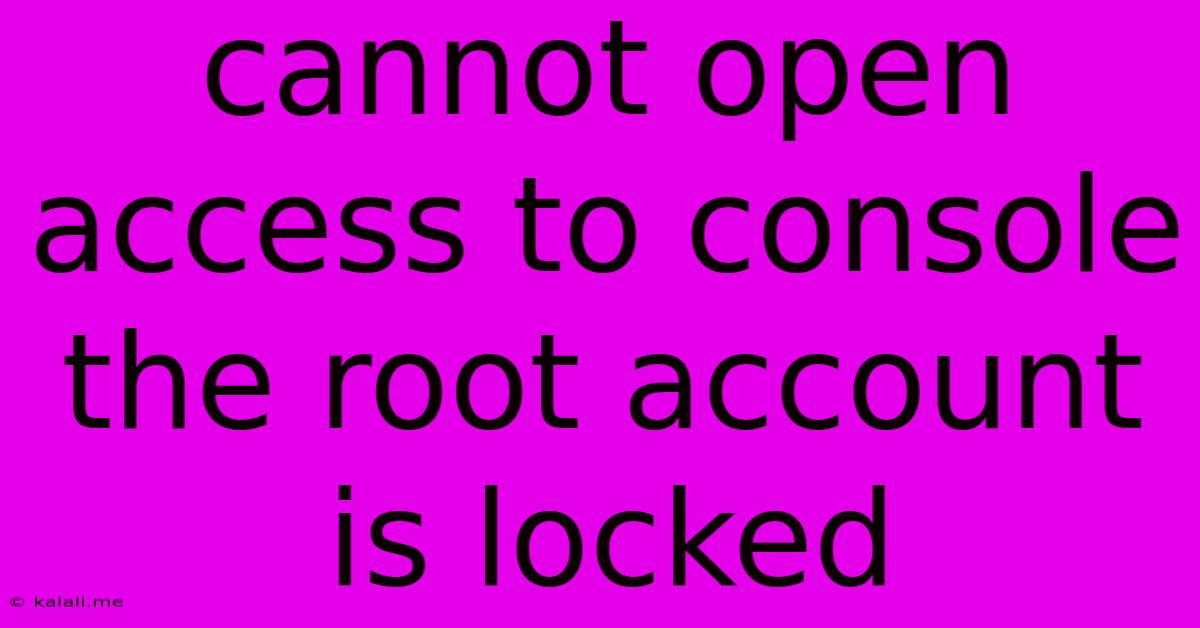Cannot Open Access To Console The Root Account Is Locked
Kalali
May 24, 2025 · 4 min read

Table of Contents
Cannot Open Access to Console: The Root Account is Locked – Troubleshooting Guide
Are you locked out of your root account and unable to access your console? This frustrating issue can stem from various causes, but thankfully, there are several troubleshooting steps you can take to regain access. This guide will walk you through the most common solutions, helping you unlock your root account and get back to work. Understanding the reason behind the lock is crucial, so let's dive into the possibilities and solutions.
Why is my root account locked?
The most frequent causes for a locked root account include:
- Incorrect Password Entry: Repeatedly entering the wrong password triggers a lockout mechanism designed to protect your system from brute-force attacks. This is a security feature, and while inconvenient, it's vital for system integrity.
- System Corruption: In some cases, system file corruption might interfere with authentication processes, leading to the root account lock.
- Compromised System: If your system has been compromised by malware or a malicious actor, they might have locked the root account to prevent access. This is a serious security issue and requires immediate action.
- Forgotten Password: Simply forgetting your root password is a common, albeit frustrating, reason for lockout.
- Configuration Errors: Incorrect system configurations can sometimes lead to unexpected account lockouts.
Troubleshooting Steps: Reclaiming Your Root Access
Let's tackle how to regain control of your locked root account. Remember to carefully follow the instructions; incorrect steps can potentially cause further damage.
1. Check for Simple Mistakes
Before delving into complex solutions, eliminate simple errors:
- Caps Lock: Ensure Caps Lock is not enabled, as passwords are often case-sensitive.
- Num Lock: Make sure Num Lock is in the correct state if your password uses numeric characters from the numeric keypad.
- Keyboard Layout: Verify your keyboard layout is correctly set. An incorrect layout can lead to incorrect character inputs.
- Password Strength: Remember that root passwords often require specific complexity; consult your system's documentation for password requirements.
2. Using Single-User Mode (Linux Systems)
For Linux distributions, booting into single-user mode allows you to access the system with limited privileges, enabling you to reset the root password. The exact process varies slightly depending on your Linux distribution, but generally involves booting your system and interrupting the boot process (often by pressing a key like Esc, Delete, or F2 - consult your system's documentation for specific keystrokes) to access the boot menu. From there, you select options related to single-user mode or recovery mode. Once in single-user mode, you can use the passwd command to reset the root password.
3. Using a Recovery or Installation Media (Linux and Other Systems)
If single-user mode doesn't work or isn't available, using a recovery or installation media (CD/DVD or USB drive) provides a way to access and reset the root password. The process involves booting from the recovery media, selecting the appropriate options to access the system's file system, and then resetting the root password using a tool provided by the recovery environment. This method usually requires a live system, allowing you to reset the password without booting your primary operating system.
4. Investigate for Malware (All Systems)
If you suspect your system has been compromised, perform a thorough malware scan using a reputable antivirus program (or a live antivirus system from a recovery environment). Removing malware is crucial to prevent further security breaches and ensure the root account remains secure after regaining access.
5. System Restore (Windows Systems)
For Windows systems, a system restore point from before the lockout occurred might resolve the issue. Access the system restore feature using the recovery environment, choose a restore point prior to the lock, and allow the system to revert to that state.
6. Reinstalling the Operating System (Last Resort)
As a last resort, reinstalling the operating system is a drastic step, but it is effective in resolving most system errors, including persistent account lockouts. Remember to back up your important data before performing a clean installation.
Preventing Future Lockouts:
- Strong Passwords: Use strong, unique passwords that are difficult to guess.
- Password Manager: Utilize a password manager to securely store and manage your passwords.
- Regular System Updates: Keep your operating system and software updated to patch security vulnerabilities.
- Regular Backups: Regularly back up your crucial data to prevent data loss in case of system failure or compromise.
By systematically following these steps, you should be able to regain access to your locked root account. Remember to prioritize security and take precautions to prevent future lockouts. If you are still experiencing issues after trying these steps, consider seeking help from experienced technical support.
Latest Posts
Latest Posts
-
Ssh Into Raspberry Pi Over Internet
May 24, 2025
-
Do Mediums Travel Throigh High Frequecny Or Low Frequency
May 24, 2025
-
What Happens If You Drive With Your Emergency Brake On
May 24, 2025
-
Onomatopoeic Air Past Lips And Teeth
May 24, 2025
-
I Was Trying To Call You
May 24, 2025
Related Post
Thank you for visiting our website which covers about Cannot Open Access To Console The Root Account Is Locked . We hope the information provided has been useful to you. Feel free to contact us if you have any questions or need further assistance. See you next time and don't miss to bookmark.